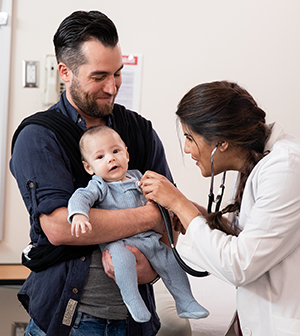When Your Child Has a Heart Murmur
When the heart beats, it makes a sound. These sounds occur as the heart valves open and close to let blood flow through the heart in the correct direction. When blood does not flow smoothly through the heart or heart valves, this turbulence causes an unusual sound, sometimes described as a "swish." This abnormal sound is a heart murmur. Heart murmurs can be harmless (innocent) or be caused by a heart problem (pathologic). Heart murmurs are common in babies and children.

What causes a heart murmur?
An innocent heart murmur is caused by mild turbulence (or rapid flowing blood) in the heart. This is normal and does not mean there is a problem. These murmurs often disappear over time. But sometimes, they can last a lifetime without causing any problems. Causes for innocent murmurs (or rapid blood flow) may include:
A pathologic heart murmur is often caused by a structural heart defect. This can include:
-
Septal defects. These are holes in the dividing walls of the heart that allow blood to pass through.
-
Heart valve problems. This means valves that have trouble opening or closing.
-
Artery-vein fistulas. These are abnormal connections between a blood vessel on the left side of the heart and a blood vessel on the right side of the heart.
-
Backflow of blood through a valve. This is because of pressure or blood flow abnormalities.
What are the symptoms of a heart murmur?
Innocent heart murmurs cause no symptoms. Symptoms related to a pathologic heart murmur depend on the underlying cause of the murmur and its severity. They may include a chronic cough, shortness of breath, dizziness, fainting, and blueish lips and fingertips.
How is a heart murmur diagnosed?
Your child's healthcare provider may detect a heart murmur during a physical exam. They can hear heart noises with a stethoscope. A heart murmur is classified by how loud it is, its location, when it occurs during the heart’s pumping cycle, the way it changes through the heartbeat, and its sound qualities. If the healthcare provider suspects the murmur is pathologic, your child may be referred to a pediatric cardiologist. This is a doctor who diagnoses and treats heart problems in children. The following tests may be done:
-
Chest X-ray. This test takes a picture of the heart and lungs. The picture can show your child’s heart size and shape. It can show some problems that may occur in the heart or lungs.
-
Electrocardiogram (ECG). During this test, the electrical activity of the heart is recorded to check for abnormal heart rhythms (arrhythmias) or problems with heart structure.
-
Echocardiogram (echo). During this test, sound waves are used to create a picture of the heart. This test can show problems with heart structure or heart function. This includes showing how well the heart pumps, if the heart is enlarged, or if there are any valve problems.
How is a heart murmur treated?
An innocent heart murmur requires no treatment because it’s not caused by a heart problem. Treatment for a pathologic murmur depends on the underlying cause and its severity. The cardiologist will evaluate your child’s condition and discuss treatment options with you if needed.
What are the long-term concerns?
Most innocent murmurs usually go away by the time children become teens or young adults. A murmur may also become louder or more noticeable, or even return if a child has a fever, is dehydrated, or has another cause of a fast heart rate. If pathologic heart murmurs aren’t diagnosed or treated, severe symptoms may result and cause serious health problems. These can include heart failure, arrhythmias, respiratory problems, or even death.